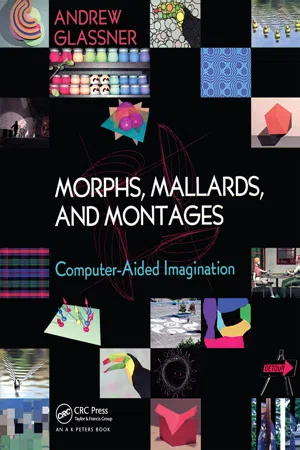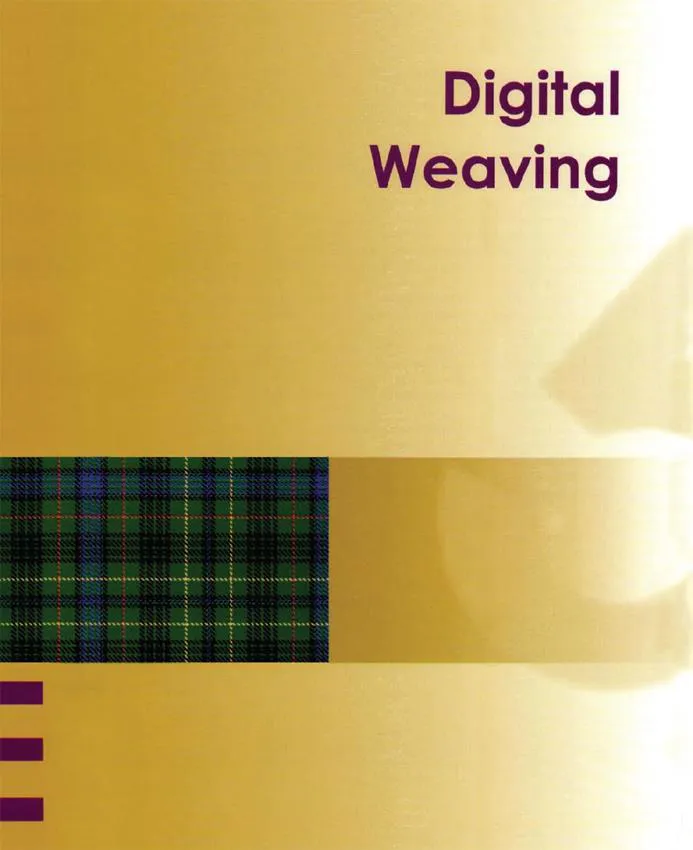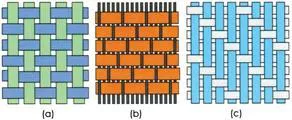
- 360 pages
- English
- ePUB (mobile friendly)
- Available on iOS & Android
eBook - ePub
About this book
This book is for everyone who's interested in computer graphics and how it can take us on exciting journeys powered by imagination and a love of discovery and invention. Each chapter investigates a unique topic and gives you the tools to continue that exploration on your own. Examine the possibilities of: - Pop-up books and cards - Reconstructing shredded documents - Crop circles - Weaves and Tartans - Morphing images and much more! Browse and enjoy the array of visual ideas or roll up your sleeves and write your own code.
Frequently asked questions
Yes, you can cancel anytime from the Subscription tab in your account settings on the Perlego website. Your subscription will stay active until the end of your current billing period. Learn how to cancel your subscription.
No, books cannot be downloaded as external files, such as PDFs, for use outside of Perlego. However, you can download books within the Perlego app for offline reading on mobile or tablet. Learn more here.
Perlego offers two plans: Essential and Complete
- Essential is ideal for learners and professionals who enjoy exploring a wide range of subjects. Access the Essential Library with 800,000+ trusted titles and best-sellers across business, personal growth, and the humanities. Includes unlimited reading time and Standard Read Aloud voice.
- Complete: Perfect for advanced learners and researchers needing full, unrestricted access. Unlock 1.4M+ books across hundreds of subjects, including academic and specialized titles. The Complete Plan also includes advanced features like Premium Read Aloud and Research Assistant.
We are an online textbook subscription service, where you can get access to an entire online library for less than the price of a single book per month. With over 1 million books across 1000+ topics, we’ve got you covered! Learn more here.
Look out for the read-aloud symbol on your next book to see if you can listen to it. The read-aloud tool reads text aloud for you, highlighting the text as it is being read. You can pause it, speed it up and slow it down. Learn more here.
Yes! You can use the Perlego app on both iOS or Android devices to read anytime, anywhere — even offline. Perfect for commutes or when you’re on the go.
Please note we cannot support devices running on iOS 13 and Android 7 or earlier. Learn more about using the app.
Please note we cannot support devices running on iOS 13 and Android 7 or earlier. Learn more about using the app.
Yes, you can access Morphs, Mallards, and Montages by Andrew Glassner in PDF and/or ePUB format, as well as other popular books in Computer Science & Programming Games. We have over one million books available in our catalogue for you to explore.
Information

5
five
Woven cloth is so common these days that many of us take it for granted. But even a moment’s examination of an everyday cloth like denim reveals some beautiful patterns.
Weavers create cloth on a mechanical device called a loom. In terms of their complexity, looms are similar to old sailing ships: the basic ideas are pretty simple, but the actual implementation can be very complex.
One reason for this complexity is the quest for simple creature comforts: weavers often spend many continuous hours working at a loom, so a lot of effort has gone into the creation of comfortable and labor-saving mechanisms to make the job as pleasant as possible. So although you can build a simple loom with almost no moving parts, most modern looms are formidable machines.
In this chapter I’ll describe enough of the basics of weaving so that we can write a loom simulator. Of course, nothing can beat actually going out and creating real, woven fabrics. My goal isn’t to replace weaving, but to use the ideas of weaving to create software tools for making patterns.
People have already brought together computers and weaving in different ways. In the Further Reading section, I’ve identified several commercial programs on today’s market that that are designed to help weavers. They are often complex and reward advanced knowledge of the craft of weaving. There’s also a very interesting weaving language built into the art program Painter, which I’ll talk about later. In fact, my wish for an interactive editor for that language was the original inspiration for this chapter.
Let’s start with the basics of weaving.
THE FIRST THREAD
A loom is typically a large wooden device with lots and lots of moving parts. In this section, I’ll simplify and abstract the structure of a loom so that we can ultimately capture its essence in a computer program.
I’ll speak of “threads” and “fabrics” in this discussion, though modern looms can weave all sorts of things, from thick, fuzzy yarns to thin, wide ribbons of satin and everything in between.
At its heart, a loom is a machine designed to interleave two sets of perpendicular threads. In one common format, one set of threads extends directly away from your body, and the others run left-to-right.
Figure 5.1 shows a simplified loom. The red fibers that go out away from us are called the warp threads, and they are fed from mechanical devices called shafts. The blue horizontal fibers are called the weft threads and are fed from devices called treadles.

A schematic version of a simple loom. The shafts along the bottom deliver the red, vertical warp threads. The treadles on the right deliver the blue, horizontal weft threads.
There is a substantial body of language associated with weaving, but I won’t go any further into that lingo here. Check the Further Reading section for glossaries and introductions.
Setting up a loom is not unlike writing a program, and indeed some people cite the task of setting up a Jacquard loom as the birth of programming. Jacquard looms were able to produce extremely intricate designs by reading weaving instructions from a deck of punched cards, which embodied the weaver’s design. Simply by loading up the loom with a different type of thread, the loom could produce many very different fabrics from the same basic pattern.
There are three fundamental types of basic weaves, which give rise to endless variations and combinations.
The most common is the plain weave, illustrated in Figure 5.2(a). In this pattern, each weft thread goes over and under each warp thread, in perfect alternation. Plain weaves are often used for clothing. An interesting variation is oxford cloth, which is often used for work shirts. Here each weft thread is actually doubled up, so although the pattern is still square, there’s double-frequency in the weft direction. This technique produces a durable yet attractive finish. You may also recognize the plain weave as the central element, or plait, of a classic Celtic knotwork panel, as I discussed in Chapter 3 of Andrew Glassner’s Other Notebook.

(a) A plain weave. (b) A satin weave. (c) A twill weave.
Another common pattern is the satin weave. In this style, the weft threads pass over several warp threads before they pass under one, as shown in Figure 5.2(b). The interlaces are staggered so that no two overlaps are adjacent to each other. Typically the warp threads are thin and strong, and the weft threads are wide, smooth, shiny, and very closely packed. This gives the fabric a smooth and luxurious look and feel.
The third common pattern is the twill weave, shown in Figure 5.2(c). Twills are like satins, but differ in three respects: they often don’t exaggerate the difference between wide and narrow threads like a satin, threads don’t usually pass over as many threads before they pass under again, and sometimes the warp threads pass over several weft threads as well. Twills are easy to spot because of their distinctive diagonal component. As opposed to a satin weave, where the interlaces are not adjacent, in most twills each thread starts one step to the left or right of the one above it, creating the diagonal. Perhaps the most common twill used today is denim: if you look closely at your favorite blue jeans, you’ll see the diagonals formed by the blue and white threads.
Now that we have some basics under our belts, let’s look at how to describe a weave.
A ROUGH DRAFT
The basic pen-and-paper schematic for setting up a loom is called a draft. A draft has three parts: the setup of the warp threads, the setup of the weft threads, and something called the tie-up, which we’ll get to in a moment.
The ability to read a draft is essential to understanding existing patterns and creating new ones. Happily, it’s a pretty straightforward process.
A basic draft is no more than four simple black-and-white grids. This technique was originally developed for hand-drawing and hand-copying drafts since it’s easy and fast to draw. It’s also great for black-and-white photocopying. Although color and computer tools are both becoming more common, the black-and-white draft remains popular for many weavers.
Although a black-and-white draft is very convenient for doodling out a new design, I f...
Table of contents
- Cover
- Half Title
- Title Page
- Copyright Page
- Dedication
- Table of Contents
- Introduction
- Chapter 01 Interactive Pop-Up Card Design
- Chapter 02 Picking Up the Pieces
- Chapter 03 Duck!
- Chapter 04 Getting the Picture
- Chapter 05 Digital Weaving
- Chapter 06 Image Search and Replace
- Chapter 07 Venn and Now
- Chapter 08 Dmorph
- Chapter 09 Everyday Computer Graphics
- Chapter 10 About Face
- Chapter 11 Rolling Your Own
- Chapter 12 Synthetic Cubism
- Chapter 13 Crop Art
- Index